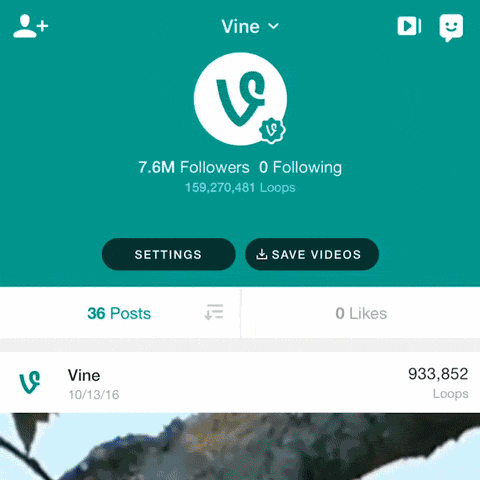As first announced back in October, Twitter is about to shut down its looping video app and social network, Vine. The company had originally implied it would pull the Vine app from the app stores, but later said it would transition it to a new, low-maintenance app called Vine Camera instead. Ahead of this, Vine’s website and app were updated to allow you to export your Vines for posterity, if you couldn’t bear to lose them.
Vines can be exported until some point today from the vine.co website, or from the iOS or Android application. The Vine website currently says you can download your Vines “only until January 17, when the apps become the Vine Camera,” but the mobile app’s banner says the app will actually be updated tomorrow.
In any event, you have only hours left to grab your Vines before they’re gone.
To begin the process from the app, you’ll need to look for the button “Save Vines” on your Profile page which will export the Vines to your Camera Roll. If you choose to instead get a download link, you can save the data referencing your videos’ Likes and reposts, too.

Another alternative is to use Giphy to turn your past Vines into GIFs. Shortly after the announcement of Vine’s closure in October, Giphy debuted its own conversion tool that exports your Vines and can be used to save them on Giphy’s site. Of course, GIFs don’t have sound, and Vines do – so Giphy’s tool will download the videos and sound files separately. This could work for those Vines that are more visual, but don’t necessarily need the audio track to make sense.
It’s unclear exactly when Vine’s app will be updated on the app stores today, but we’re down to the final hours at this point.
Vine, which was once a vibrant social network capable of producing its own stars, and a top-rated social app, will then transform into a more basic utility. The new Vine Camera will simply allow you to record 6-second looping videos, but there will no longer be a community where these can be shared.
For a service that once had more than 200 million active users, Vine’s demise speaks to Twitter’s inability to capitalize on the technology and network it acquired back in 2012. The company missed opportunities to deeply integrate Vine into Twitter, similar to how Instagram uses its feeder apps Boomerang, Layout and Hyperloop to help users create engaging content. By allowing Vine’s social network to establish itself as a separate entity from Twitter’s, the company also missed the opportunity to bring more people to Twitter’s platform and increase engagement among existing users.
Vine also faced issues with bots, as does Twitter, and didn’t offer an easy a way for creators to make money, compared with other video platforms, like YouTube.
The closure had sparked some anger and sadness among users, but also from Vine founder Rus Yusupov who tweeted about Vine’s death, with a reminder to other founders: “don’t sell your company!”
